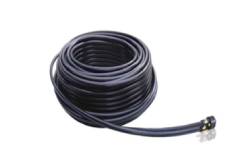In the production process of plastic extrusion pc cable pipe, extrusion is a link that has a very important impact on the final product form. In the process of communicating with many friends who make cable products, we found that there are actually many problems that you will often encounter. Today, the custom plastic rods supplier makes a brief summary for everyone, hoping to be beneficial to R & D engineers.

Plastic Extrusion Pc Cable Pipe
A phenomenon that produces
(1) The plutonium generated during the plasticization of the resin has small crystal points and small particles on the surface of the plastic layer and is distributed around the surface of the plastic layer.
(2) The scorch produced by scorch has scorch on the surface of the plastic layer, which is particularly reflected on the surface of the glued seam.
(3) Impurities: There are impurities on the plastic surface, and there are impurities in the sliced contamination.
(4) The plastic ravioli produced by poor plasticization, after slicing, it was found that the ravioli was cooked.
● What causes radon
(1) Due to the low temperature control, the plastic is extruded from the machine head before it is plasticized.
(2) The plastic is of poor quality, and there are resins that are difficult to plasticize. These are extruded without being completely plasticized.
(3) Some impurities are added to the hopper during feeding, which causes impurities to scoop.
(4) The temperature is controlled to be too high, which causes scorch, which results in scorch.
(5) The mold cover is not pressed tightly, and it deteriorates after being fed, and scorch appears.
● How to exclude radon
(1) The radon caused by the plastic itself should be appropriately raised in temperature.
(2) Strictly check the plastic for debris during feeding. Do not add other debris into the hopper when feeding. If impurities are found, clean the machine head immediately and run away the glue stored in the screw.
(3) If the temperature is found to be too high, immediately reduce the temperature appropriately. If the effect is not good, immediately clean the machine head and screw to eliminate scorch.
(4) Resin concrete and poorly plasticized concrete are found. Adjust the temperature appropriately or reduce the screw and traction speed.
Positive and negative tolerances of the plastic layer
● Out of tolerance
(1) The speed of the screw and traction is unstable, and the ammeter or voltmeter swings left and right, which affects the outer diameter of the cable and produces deviations in the plastic layer.
(2) There is a problem with the quality of the semi-finished product. For example, the steel strip or plastic strip is loosely wrapped, causing uneven unevenness or the plastic layer has defects such as packages, edges, and pits.
(3) The temperature control is extremely high, resulting in a reduction in the amount of extrusion, which suddenly makes the outer diameter of the cable thinner and the plastic layer thinner, forming a negative difference.
● Causes of excess
(1) The core or cable core is not round and has a serpentine shape, and the outer diameter changes too much.
(2) There are quality problems in semi-finished products, such as: steel belt joints are not good, steel belt loose sleeves, steel belt curling, plastic belt loose sleeves, joints are too large, loose flowers, etc.
(3) During operation, the selection of the mold core is too large, which will cause the glue to pour and cause the plastic layer to eccentric.
(4) When adjusting the mold, the mold adjustment screw is not tightened, which will cause the buckle phenomenon to make the plastic layer eccentric.
(5) The screw or traction speed is not stable, causing excess tolerance.
(6) The feeding port or filter screen is partially blocked, resulting in a decrease in the amount of glue and a negative difference.
● Ways to exclude out of tolerance
(1) Often measure the outer diameter of the cable and check the thickness of the plastic layer. If the outer diameter changes or the plastic layer is uneven, it should be adjusted immediately.
(2) The matching mold should be suitable. After adjusting the mold, tighten the mold adjustment screw and press the gland tightly.
(3) Pay attention to the current and voltmeter of the screw and traction. If it is unstable, find an electrician and a fitter in time for maintenance.
(4) Do not add strips or other sundries into the hopper. If this is found, remove it immediately.